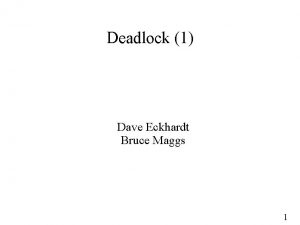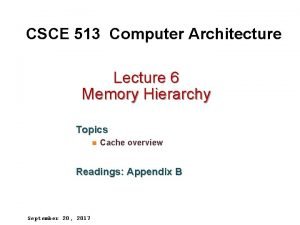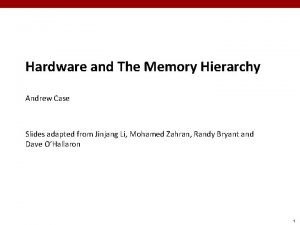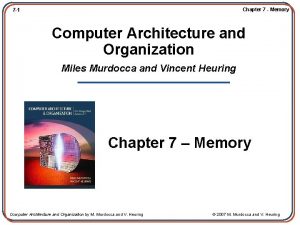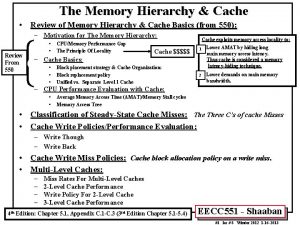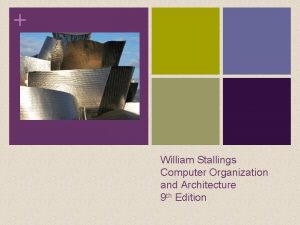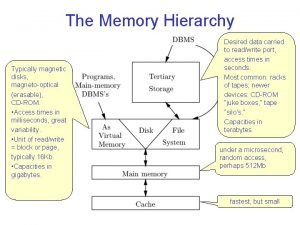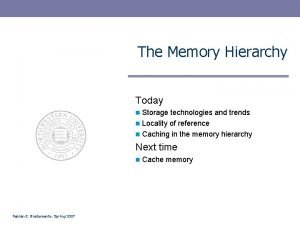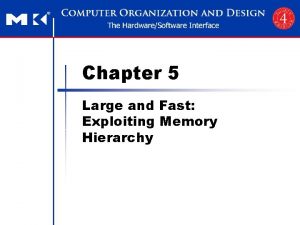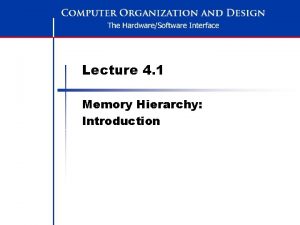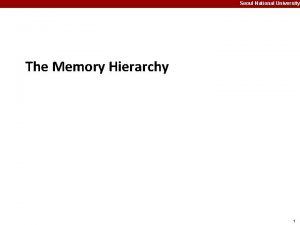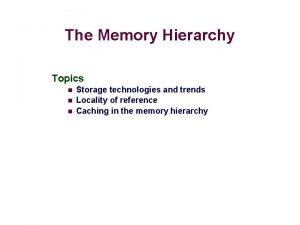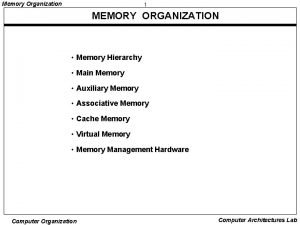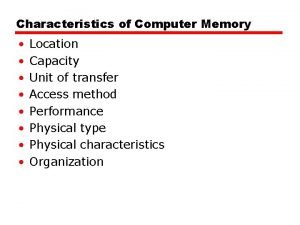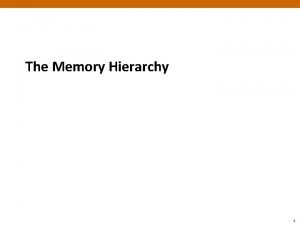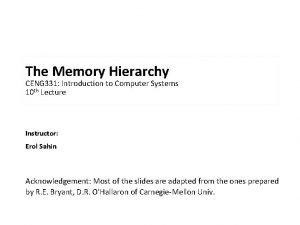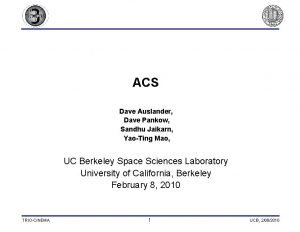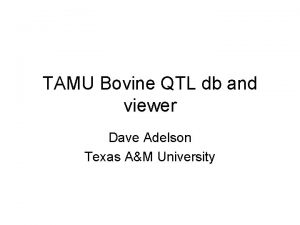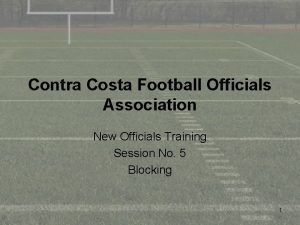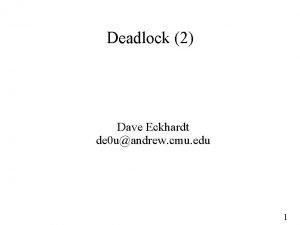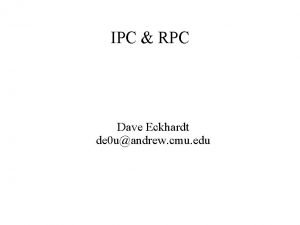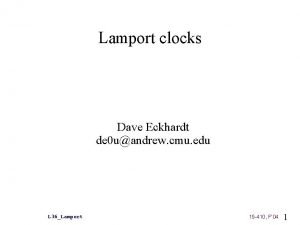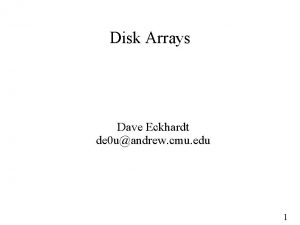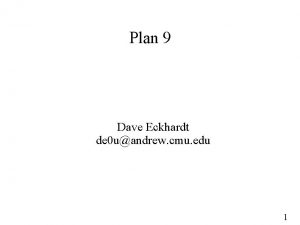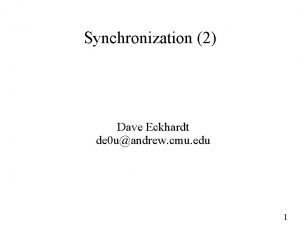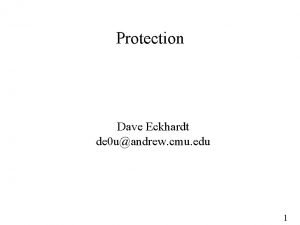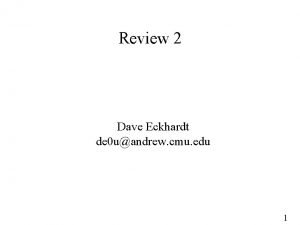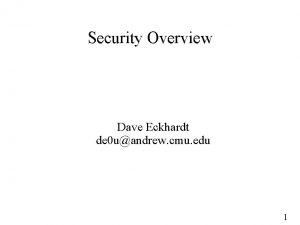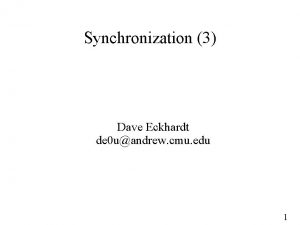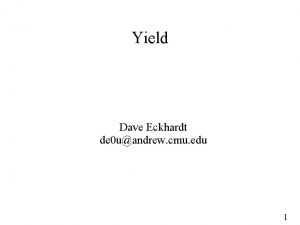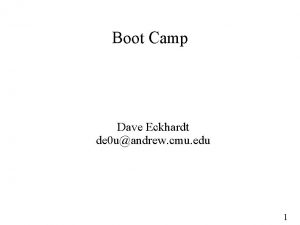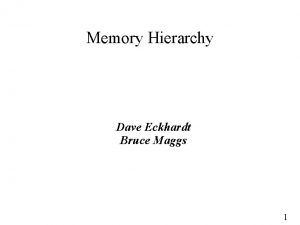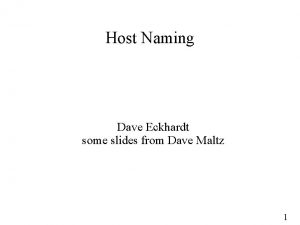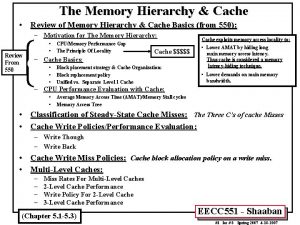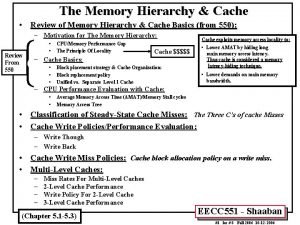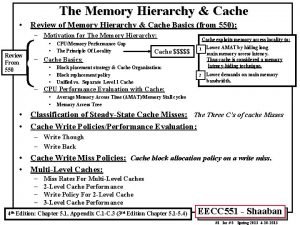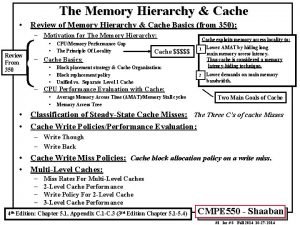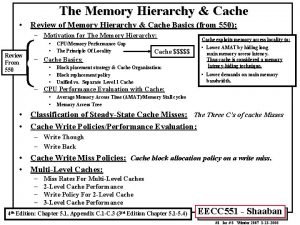Memory Hierarchy Dave Eckhardt de 0 uandrew cmu







































- Slides: 39

Memory Hierarchy Dave Eckhardt de 0 u@andrew. cmu. edu 1

Outline ● ● Lecture versus book – Some of Chapter 2 – Some of Chapter 10 Memory hierarchy – A principle (not just a collection of hacks) 1

Am I in the wrong class? ● “Memory hierarchy”: OS or Architecture? – ● Yes Why cover it here? – OS manages several layers ● ● ● – RAM cache(s) Virtual memory File system buffer cache Learn core concept, apply as needed 1

Memory Desiderata ● Capacious ● Fast ● Cheap ● Compact ● Cold – ● Pentium-4 2 Ghz: 75 watts!? Non-volatile (can remember w/o electricity) 1

You can't have it all ● Pick one – ok, maybe two ● Bigger slower (speed of light) ● Bigger more defects – ● If constant per unit area Faster, denser hotter – At least for FETs 1

Users want it all ● ● The ideal – Infinitely large, fast, cheap memory – Users want it (those pesky users!) They can't have it – Ok, so cheat! 1

Locality of reference ● Users don't really access 4 gigabytes uniformly ● 80/20 “rule” ● – 80% of the time is spent in 20% of the code – Great, only 20% of the memory needs to be fast! Deception strategy – Harness 2 (or more) kinds of memory together – Secretly move information among memory types 1

Cache ● Small, fast memory. . . ● Backed by a large, slow memory ● Indexed via the large memory's address space ● Containing the most popular parts – (at present) 1

Cache Example – Satellite Images ● SRAM cache holds popular pixels ● DRAM holds popular image areas ● Disk holds popular satellite images ● Tape holds one orbit's worth of images 1

Great Idea. . . ● Clean general-purpose implementation? – ● ● #include <cache. h> No: tradeoffs different at each level – Size ratio: data address / data size – Speed ratio – Access time = f(address) But the idea is general-purpose 1

Pyramid of Deception 1

Key Questions ● Line size ● Placement/search ● Miss policy ● Eviction ● Write policy 1

Today's Examples ● L 1 CPU cache – Smallest, fastest – Maybe on the same die as the CPU – Maybe 2 nd chip of multi-chip module – Probably SRAM – 2003: “around a megabyte” ● – ~ 0. 1% of RAM As far as CPU is concerned, this is the memory ● Indexed via RAM addresses (0. . 4 GB) 1

Today's Examples ● Disk block cache – Holds disk sectors in RAM – Entirely defined by software – ~ 0. 1% to maybe 1% of disk (varies widely) – Indexed via (device, block number) 1

“Line size” = item size ● ● Many caches handle fixed-size objects – Simpler search – Predictable operation times L 1 cache line size – ● 4 32 -bit words (486, IIRC) Disk cache line size – Maybe disk sector (512 bytes) – Maybe “file system block” (~16 sectors) 1

Picking a Line Size ● What should it be? – Theory: see “locality of reference” ● (“typical” reference pattern) 1

Picking a Line Size ● Too big – Waste throughput ● – Waste cache space reduce “hit rate” ● ● ● Fetch a megabyte, use 1 byte String move: *q++ = *p++ Better have at least two cache lines! Too small – Waste latency ● Frequently must fetch another line 1

Content-Addressable Memory ● ● ● RAM – store(address, value) – fetch(address) value CAM – store(address, value) – fetch(value) address “It's always the last place you look” – Not with a CAM! 1

Memory Contents 1

RAM + CAM = Cache 1

RAM + CAM = Cache 1

RAM + CAM = Cache 1

Content-Addressable Memory ● CAMS are cool! ● But fast CAMs are small (speed of light, etc. ) ● If this were an architecture class. . . – We would have 5 slides on associativity – Not today: only 2 1

Placement/search ● Placement = "Where can we put ____? " – “Direct mapped” - each item has one place ● – "Fully associative" - each item can be any place ● ● Think: hash function Think: CAM Direct Mapped – Placement & search are trivial – False collisions are common – String move: *q++ = *p++; – Each iteration could be two cache misses! 1

Placement/search ● ● Fully Associative – No false collisions – Cache size/speed limited by CAM size Choosing associativity – Trace-driven simulation – Hardware constraints 1

Thinking the CAM way ● Are we having P 2 P yet? – I want the latest freely available Janis Ian song. . . ● – ● www. janisian. com/article-internet_debacle. html . . . who on the Internet has a copy for me to download? I know what I want, but not where it is. . . – . . . Internet as a CAM 1

Sample choices ● ● L 1 cache – Often direct mapped – Sometimes 2 -way associative – Depends on phase of transistor Disk block cache – Fully associative – Open hash table = large variable-time CAM – Fine since "CAM" lookup time << disk seek time 1

Miss Policy ● ● Miss policy: {Read, Write} X {Allocate, Around} – Allocate: miss allocate a slot – Around: miss don't change cache state Example: Read-allocate, write-around – Read miss ● ● – Allocate a slot in cache Fetch data from memory Write miss ● Store straight to memory 1

Miss Policy – L 1 cache ● Mostly read-allocate, write-allocate ● But not for "uncacheable" memory – . . . such as Ethernet card ring buffers ● “Memory system” provides “cacheable” bit ● Some CPUs have "write block" instructions for gc 1

Miss Policy – Disk-block cache ● Mostly read-allocate, write-allocate ● What about reading (writing) a huge file? – Would toast cache for no reason – See (e. g. ) madvise() 1

Eviction ● “The steady state of disks is 'full'”. ● Each placement requires an eviction ● – Easy for direct-mapped caches – Otherwise, policy is necessary Common policies – Optimal, LRU – LRU may be great, can be awful – 4 -slot associative cache: 1, 2, 3, 4, 5, . . . 1

Eviction ● ● Random – Pick a random item to evict – Randomness protects against pathological cases – When could it be good? L 1 cache – ● LRU is easy for 2 -way associative! Disk block cache – Frequently LRU, frequently modified – “Prefer metadata”, other hacks 1

Write policy ● ● Write-through – Store new value in cache – Also store it through to next level – Simple Write-back – Store new value in cache – Store it to next level only on eviction – Requires “dirty bit” – May save substantial work 1

Write policy ● ● L 1 cache – It depends – May be write-through if next level is L 2 cache Disk block cache – Write-back – Popular mutations ● ● ● Pre-emptive write-back if disk idle Bound write-back delay (crashes happen) Maybe don't write everything back (“softatime”) 1

Translation Caches ● Address mapping – CPU presents virtual address (%CS: %EIP) – Fetch segment descriptor from L 1 cache (or not) – Fetch page directory from L 1 cache (or not) – Fetch page table entry from L 1 cache (or not) – Fetch the actual word from L 1 cache (or not) 1

“Translation lookaside buffer” (TLB) ● Observe result of first 3 fetches – ● ● Segmentation, virtual physical mapping Cache the mapping – Key = virtual address – Value = physical address Q: Write policy? 1

Challenges – Write-back failure ● Power failure? – ● Battery-backed RAM! Crash? – Maybe the old disk cache is ok after reboot? 1

Challenges - Coherence ● Multiprocessor: 4 L 1 caches share L 2 cache – What if L 1 does write-back? ● TLB: v p all wrong after context switch ● What about non-participants? – ● I/O device does DMA Solutions – Snooping – Invalidation messages (e. g. , set_cr 3()) 1

Summary ● ● Memory hierarchy has many layers – Size: kilobytes through terabytes – Access time: nanoseconds through minutes Common questions, solutions – Each instance is a little different – But there are lots of cookbook solutions 1
 Dave eckhardt
Dave eckhardt Virtual memory in memory hierarchy consists of
Virtual memory in memory hierarchy consists of Dr. eckhardt biermann
Dr. eckhardt biermann Memory hierarchy
Memory hierarchy Memory hierarchy
Memory hierarchy Memory hierarchy in coa
Memory hierarchy in coa Memory hierarchy in os
Memory hierarchy in os Draw memory hierarchy diagram
Draw memory hierarchy diagram Computer memory hierarchy diagram
Computer memory hierarchy diagram Magnetic disk in memory hierarchy
Magnetic disk in memory hierarchy Memory hierarchy
Memory hierarchy Large and fast: exploiting memory hierarchy
Large and fast: exploiting memory hierarchy Explain memory hierarchy
Explain memory hierarchy Memory hierarchy
Memory hierarchy Memory hierarchy definition
Memory hierarchy definition ड्रा मेमोरी हायरार्की
ड्रा मेमोरी हायरार्की What is memory organization
What is memory organization Computer architecture
Computer architecture Memory hierarchy
Memory hierarchy Characteristics of computer memory
Characteristics of computer memory Memory hierarchy diagram
Memory hierarchy diagram Memory hierarchy
Memory hierarchy Which memory is the actual working memory?
Which memory is the actual working memory? Shared vs distributed memory
Shared vs distributed memory Internal memory and external memory
Internal memory and external memory Page fault
Page fault Semantic features definition
Semantic features definition Primary memory and secondary memory
Primary memory and secondary memory Implicit explicit memory
Implicit explicit memory Eidetic memory vs iconic memory
Eidetic memory vs iconic memory Memory swaping
Memory swaping Long term memory vs short term memory
Long term memory vs short term memory Dave simpson rbc
Dave simpson rbc Dave provenzano
Dave provenzano Dave pankow
Dave pankow What occurs when a wave bounces off an object
What occurs when a wave bounces off an object 11172016
11172016 Dave adelson
Dave adelson Dave cutaia
Dave cutaia Dave feinberg
Dave feinberg
